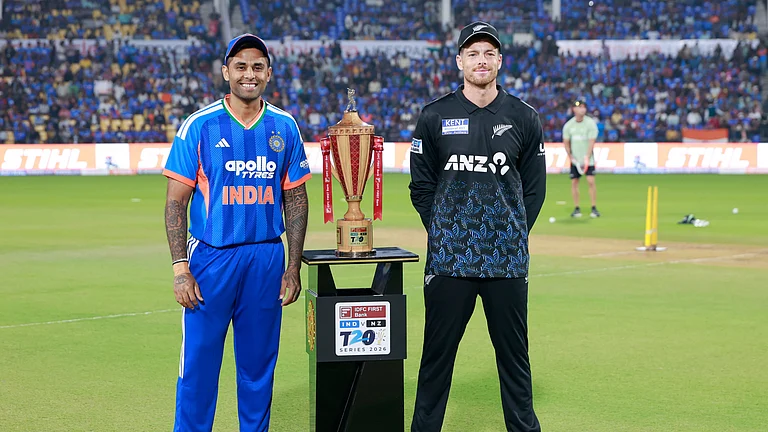As we lose the uniqueness of our urban visual history, with the soulless replication of commercial spaces at the cost of hundreds of beautiful old architectural landmarks, we also lose the stories of the people and their human relationships with those spaces. While progress and change cannot be stopped, I doubt if millennials will ever tell their future grandchildren stories of shopping malls and multiplexes, and how attached they were to them, and the social or cultural impact they had on their lives.
The Thakur of Wadhwan, Gujarat, was present at Watson’s Hotel in Bombay in 1896 when the Lumiere brothers showcased their Cinematographe for the first time in India. As per the available oral history, the Thakur was so enchanted by this new device that he immediately paid for one to be shipped to him from France. The Cinematographe arrived 10 years later, in 1906, and was operated at an open ground in Wadhwan to show silent movies after sunset. The ground and the ticket window still exist.
In the days of silent movies music would be played live by one or two people, or even by an orchestra, in an effort to make the viewing experience more engaging. Many of the old proscenium-style theatres had a pit for the musicians, which allowed an easy transition to the silent movie era. The stage would be covered by a screen, and the musicians played on. The owner of the long-since defunct Bharat Talkies in central Maharashtra told me of the time it used to be a silent cinema. His educated grandfather would read the story of the film being screened off a sheet of paper in real time, while the grand uncles would play live music on the harmonium, the flute and the tabla.

The advent of the talkies ended the careers of hundreds of musicians who were making a living playing music for several movie shows a day. Some of them found work with film composers. Sometimes over a hundred musicians would rehearse a composition together, complete with sheet music and a conductor. Eventually, most of these musicians lost their livelihood when sound software allowed you to multiply the number of musicians with a click of a button. No longer did you have to pay 150 people for several days to record one song. Individual idiosyncratic human abilities were discarded.
There was an era when the most important person in a cinema theatre was the projector operator, often more than the owner! Projectors were high-precision clockwork machines, and projectionists were divas, and the functioning of the cinema depended entirely on them. The true art of a perfect projectionist lay in the deftness with which he could start a second projector, once the reel on the first projector was about to run out. The skill lay in his ability to make the timing seamless, with the audience never noticing a reel change. In the days of old vacuum tube and stereo amplifiers, there was a technique of “Fake Surround Sound”. A few additional speakers would be placed around the auditorium, connected to a second amplifier with a separate volume control knob. The projectionist was responsible for activating the second amplifier by controlling the volume knob during songs, fight sequences or even explosions and bullet shots, making them louder at key moments of the movie. There are stories I’ve heard from cinema owners and projectionists—how directors like Raj Kapoor, Feroz Khan and Manoj Kumar would attend a premiere at a cinema theatre and actually seek out the projectionist and reward him for his immaculate skills. Today, a bored twenty-something enters a code into the digital system in the morning and sleeps all day.

A cinema in Shimla was created as a reaction to the restrictions laid down by the British for the cinema theatres on the Mall where only a certain class of gentry were allowed, and had to adhere to strict dress codes. One afternoon, a Shahi Hakim (a royal doctor who had relocated to Shimla from pre-partition Pakistan) gave his staff the day off and some money to watch a movie. Later in the day, he found them loitering around the clinic and when he asked them which movie they had watched, he discovered they had been barred from entering the Mall because of their lack of ‘presentability’ and their low social standing. Sharma ji, the Hakim, decided to build Shahi Cinema outside the Mall precinct, specifically for the people outside the accepted social class. The chief guests were a local sweeper and a coolie, who inaugurated the cinema. Ironically, all the cinemas on the Mall have long since closed, but Shahi Cinema is still showing four shows a day.
It is common knowledge that the rapid and government-favoured growth of the multiplex concept destroyed single screen cinemas, and led to the exclusion of an entire social strata of cinema-goers, who now rely on their cellphones and data packages to watch movies.

Hand-painted film posters are also a thing of the past. I had the honour and privilege of meeting the octogenarian Sheikh Rehman at Alfred Talkies in Mumbai. He is the last of the film poster artists of that era and spends his time painting commissioned posters for a handful of fans. He mentioned the hilarious thought processes before a new movie released: the owner and manager would be hoping for a silver jubilee at the very least, while he would be wishing for the film to flop. If the film ran for 25 weeks, he would end up being out of work! His father had also been a pioneering film-poster artist, and actually began his career painting posters for plays. He had perfected the art of making moving mechanical elements and light bulbs in series to create animated film billboards. To the extent that the police had to order the cinema owner to run the animated effects only for 30 minutes before the show began; they were so distracting that traffic would pile up and people would ram their vehicles into each other.

With everything going digital, this entire style was also lost. And interestingly, the old artists would have to reuse the canvas sheets they painted on, so, once a movie was taken down, the related artwork was erased. A cinema owner in Varanasi told me that when he took over the cinema, on the days of unruly crowds, the elderly manager had taught him the specific skill of choosing which potential patron to slap as a display of authority, to always slap someone who is alone and not in a group! Another owner told me, with a grin, how cinema exhibition was once the only business in the world in which you could thrash your clients every day, and they would still be back for the next show!
I asked a veteran cinema manager in Mumbai how he felt today, 40 years after joining that cinema, watching a handful of reluctant patrons trickling into his cinema, after having experienced the era of massive and energetic crowds. He said that the single screen cinema owners were paying for the arrogance of their successful days today.

Gone are the days of advance booking, black marketing, hand-stamped tickets, long queues, overwhelming crowds, police presence, lathi charges, balconies and boxes, upper and lower stalls and dress circles, and dancing in the aisles. We have forgotten how different an experience it was to watch a good movie with a thousand people beside you. The sound and picture may be superior today, but the experience is not.
When I photographed my first single-screen cinema in January 2019, Lakshmi Talkies had an idol of Goddess Lakshmi in the lower lobby. She was covered with dust, and one of her four arms was missing. Since then, the cinema has been completely stripped of everything, including the idol, as the structure is being prepped for demolition, 71 years after it was built.
I guess Lakshmi too, has left the building…
(Text & photographs by Hemant Chaturvedi)
(This appeared in the print as 'Residual Memory')
Hemant Chaturvedi was a cinematographer in the Hindi film industry and is now a still photographer





















